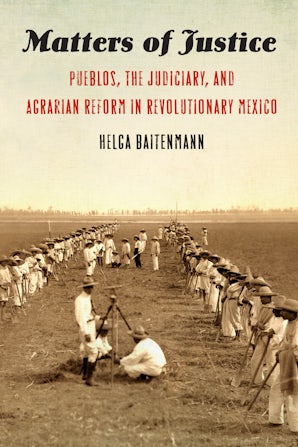(Source: University of Nebraska Press)
The University of Nebraska press
is publishing a book on agrarian reform in early 20th century Mexico.
ABOUT THE BOOK
After the fall of the Porfirio
Díaz regime, pueblo representatives sent hundreds of petitions
to Pres. Francisco I. Madero, demanding that the executive branch of
government assume the judiciary’s control over their unresolved lawsuits
against landowners, local bosses, and other villages. The Madero administration
tried to use existing laws to settle land conflicts but always stopped short of
invading judicial authority.
In contrast, the two main agrarian reform programs undertaken in revolutionary Mexico—those implemented by Emiliano Zapata and Venustiano Carranza—subordinated the judiciary to the executive branch and thereby reshaped the postrevolutionary state with the support of villagers, who actively sided with one branch of government over another.
In Matters of Justice Helga Baitenmann offers the first detailed account of the Zapatista and Carrancista agrarian reform programs as they were implemented in practice at the local level and then reconfigured in response to unanticipated inter- and intravillage conflicts. Ultimately, the Zapatista land reform, which sought to redistribute land throughout the country, remained an unfulfilled utopia. In contrast, Carrancista laws, intended to resolve quickly an urgent problem in a time of war, had lasting effects on the legal rights of millions of land beneficiaries and accidentally became the pillar of a program that redistributed about half the national territory.
ABOUT THE AUTHOR
Helga Baitenmann is
an associate fellow of the Institute of Latin American Studies at the
University of London. She is the coeditor of Decoding Gender: Law and
Practice in Contemporary Mexico.
TABLE OF CONTENTS
List of Illustrations
Acknowledgments
Introduction: Hidden Histories of Revolutionary Agrarian Reform
1. The Inherent Difficulties of Winning Pueblo Land and Water Suits in Nineteenth-Century Mexico
2. Pueblo Land and Water Claims during the Madero Administration, 1911–1913
3. The Zapatista Land Reform, 1911–1916
4. The Constitutionalist Land Reform in the Absence of the Judiciary, 1914–1917
5. The Return of the Judiciary in Uncertain Times, 1917–1924
6. The Morelos Laboratory, 1920–1924
Epilogue: Zapatista and Constitutionalist Agrarian Reforms Compared
Glossary
Notes
Bibliography
Index
Acknowledgments
Introduction: Hidden Histories of Revolutionary Agrarian Reform
1. The Inherent Difficulties of Winning Pueblo Land and Water Suits in Nineteenth-Century Mexico
2. Pueblo Land and Water Claims during the Madero Administration, 1911–1913
3. The Zapatista Land Reform, 1911–1916
4. The Constitutionalist Land Reform in the Absence of the Judiciary, 1914–1917
5. The Return of the Judiciary in Uncertain Times, 1917–1924
6. The Morelos Laboratory, 1920–1924
Epilogue: Zapatista and Constitutionalist Agrarian Reforms Compared
Glossary
Notes
Bibliography
Index
More info here


No comments:
Post a Comment